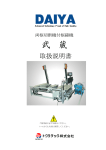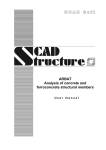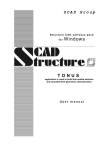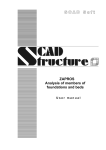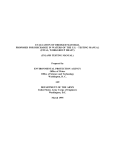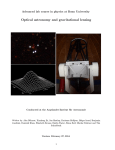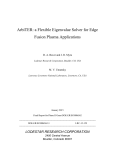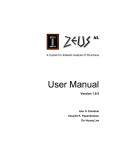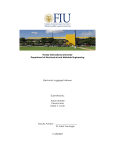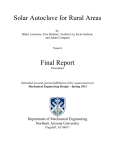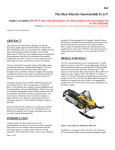Download KUST - Scad
Transcript
SCAD Soft Structure CAD software system for Windows 95/98/NT KUST Oscillations, Stability, Statics Version 1.1 User manual UDC 539.3+624.014 Team of authors S.V. Girenko, E.Z. Kriksunov, A.V. Perelmuter, M.A. Perelmuter, S.Y. Fialko «KUST». Oscillations Stability Statics. USER MANUAL. Version 1.1. The manual contains a description of the functionality of the KUST software, its technologies, and recommendations on its usage. The software is oriented at engineers and designers who have basic skills with personals computers. © SCAD Soft, 2004 TABLE OF CONTENTS GENERAL INFORMATION.................................................................................................................................... 5 INTERFACE............................................................................................................................................................... 6 CONTROLS................................................................................................................................................................ 8 SETTINGS ................................................................................................................................................................ 10 STABILITY OF EQUILIBRIUM........................................................................................................................... 12 1. 2. 3. 4. 5. 6. 7. 8. 9. 10. 11. 12. 13. 14. 15. 16. 17. 18. 19. 20. SINGLE-SPAN UNIFORM-SECTION BARS ON STIFF SUPPORTS ........................................................................ 12 SINGLE-SPAN BARS ON ELASTICALLY DISPLACEABLE OR INCLINABLE SUPPORTS ......................................... 13 SINGLE-SPAN VARIABLE-SECTION BARS ON STIFF SUPPORTS............................................................................ 14 SINGLE-SPAN STRAIGHT BARS OF UNIFORM SECTION ON ELASTIC FOUNDATION .......................................... 16 MULTI-SPAN UNIFORM-SECTION BARS ON ELASTIC SUPPORTS ..................................................................... 18 CIRCULAR RING............................................................................................................................................... 19 CIRCULAR ARCHES (STABILITY IN PLANE)....................................................................................................... 20 PARABOLIC ARCHES (STABILITY IN PLANE)..................................................................................................... 22 SHALLOW TWO-HINGED ARCHES (STABILITY IN PLANE) ................................................................................. 23 STABILITY OF PLANE FLEXURE OF THIN-WALLED BEAMS ................................................................................ 24 RECTANGULAR PLATE ..................................................................................................................................... 25 ROUND PLATE ................................................................................................................................................. 26 SKEW PLATE ................................................................................................................................................... 28 CYLINDRICAL PANEL ....................................................................................................................................... 29 CONICAL PANEL .............................................................................................................................................. 30 SPHERICAL PANEL ........................................................................................................................................... 31 CIRCULAR CYLINDRICAL SHELL....................................................................................................................... 32 ELLIPTIC CYLINDRICAL SHELL ......................................................................................................................... 34 TRUNCATED CIRCULAR CONICAL SHELL ......................................................................................................... 35 SPHERICAL SHELL ........................................................................................................................................... 36 NATURAL OSCILLATION FREQUENCIES...................................................................................................... 37 21. 22. 23. 24. 25. 26. 27. 28. 29. SINGLE-SPAN UNIFORM-SECTION BARS ON STIFF SUPPORTS ............................................................................. 37 SINGLE-SPAN BARS ON ELASTIC FOUNDATION ................................................................................................. 38 BARS OF VARIABLE SECTION............................................................................................................................ 39 ROUND RINGS .................................................................................................................................................. 40 STRINGS .......................................................................................................................................................... 41 RECTANGULAR PLATES .................................................................................................................................... 42 ROUND PLATES ................................................................................................................................................ 44 CYLINDRICAL SHELL........................................................................................................................................ 45 CONICAL SHELL ............................................................................................................................................... 46 OTHER OSCILLATION PROBLEMS ................................................................................................................. 47 30. REFERENCE DATA ABOUT INTERNAL FRICTION ................................................................................................ 47 STATIC ANALYSIS ................................................................................................................................................ 48 31. ROUND PLATES ................................................................................................................................................ 48 32. RECTANGULAR PLATES .................................................................................................................................... 51 KUST 33. SPHERICAL DOMES ........................................................................................................................................... 52 AUXILIARY CALCULATIONS ............................................................................................................................ 54 34. 35. 36. 37. 38. 39. 4 POLYNOMIAL ROOTS ....................................................................................................................................... 54 MOMENTS OF INERTIA OF SIMPLE BODIES ......................................................................................................... 55 GEOMETRICAL PROPERTIES ........................................................................................................................... 58 DETERMINANT OF MATRIX ............................................................................................................................... 60 INVERSE MATRIX.............................................................................................................................................. 61 LINEAR EQUATION SYSTEMS ........................................................................................................................... 62 KUST General information The reference manual program KUST is developed by the SCAD Soft company and included in the SCAD Office software package. It solves particular classes of mechanical problems for which there exist analytical or sufficiently accurate approximate solutions published in literature on the subject. Though the majority of these problems can be also solved by the SCAD software, involving KUST will enable one to get a solution without building any design finite-element models. Also, some of results obtained by KUST can be used to specify source data when building a finite-element model (such data as coefficients of effective length, estimates of natural frequencies etc.). All problems which the program is capable of solving can be classified into the following categories: ♦ stability of equilibrium; ♦ frequencies of natural oscillations; ♦ other oscillation problems; ♦ static calculations; ♦ auxiliary calculations. Formulations of most of the problems in question are quite clear, therefore for each problem this manual gives only brief statements, lists of source data needed, and results to be obtained by solving it. More details can be found in literature referred to in each section. 5 KUST Interface Fig. 1. The main window of the KUST program The main window of the KUST program has the same set of controls in all working modes; these controls include: • • • • a tree of problems used to select a type of the analysis; edit fields to specify source data; fields where results of the analysis will be displayed; functional buttons to activate the analysis and invoke various control actions (start the analysis, form a report, open the reference help, …). Problem tree The problem tree has three levels of hierarchy. The first, highest, level contains names of problem groups such as STABILITY OF EQUILIBRIUM or NATURAL OSCILLATION FREQUENCIES. The second level contains types of constructions such as Bars, Plates; the third level suggests particular problems. To invoke a problem type, place the mouse pointer onto its title and left-click. Edit fields When editing data in the edit fields, you can enter numbers as fixed-point values (such as 0.214) or in a scientific notation (such as 1.23е5). The integer and the fractional parts are separated by a period. A comma can be used, too, but this must be set up in the Windows environment settings. The data entered in the fields are checked when the analysis is activated. Functional buttons Functional buttons are used to invoke the following control actions: 6 KUST Calculate to invoke actions of source data checking and performing the calculation itself; Report to form a report containing results of the calculation/analysis; Settings to activate a program setup mode (see below); Help to get reference help information about KUST; Fig. 2. The Search the problem tree dialog box Find to search the problem tree for a context in a problem’s name. The search is done using the Search the problem tree dialog box (Fig. 2) where you should specify a text to search for and click the Find button. This will open a list of all problems the titles of which contain the specified text in the Search results list. Place the mouse pointer onto the desired problem and click the Go to button; the focus of the tree will switch to the problem pointed to. To proceed with the analysis, close the search dialog box. Exit to end the active working session and exit the program. Calculate To perform the calculation, select a problem in the problem tree, specify source data for it in the edit fields, and click the Calculate button. 7 KUST Controls Principles of control implemented in the software are intended to provide the unified dialogue functions. This software uses a common dialog box technique. The following controls and ways of data access are used: ♦ functional buttons “clicking” which (by placing the mouse pointer onto a button and clicking the left mouse button) takes you to particular modes or actions; ♦ selection tools of various kinds which enable you to choose one or more of suggested options; ♦ data edit fields using which you specify source data for the analysis. Source data consist of numbers. If a noninteger number is entered, its integral and fractional parts are separated with a period or another separator. The separator is assigned by the user during the setup of the operating system (see Settings | Regional Settings | Number). Number can be entered also in the scientific notation, for example, as 1.56e-7; ♦ drop-down and static lists from which to select data; ♦ tables to enter or display tabular information; ♦ dynamically digitized diagrams that display values of functions for an argument pointed to by the mouse pointer on the screen. Material properties Many of the problems solved by KUST require you to specify physical properties of materials that a structure is made of. In most cases this information can be specified in a unified way. There is a drop-down list (see Fig. 3) from which you can choose the desired material. Fig. 3. The Materials drop-down list. When you select a material in the list, all properties will be retrieved from a database shipped with the software. To check your selection, the program will display the properties of the selected material (such as the elasticity modulus, Poisson ratio etc.). If you select the bottom item of the list, “OTHER MATERIAL”, the respective edit fields will be enabled so that you can enter mechanical properties of the material absent in the database manually. Before doing the analysis, the program will check the correctness of the information entered (for example, no Poisson ratio greater than 0.5 can be specified). Moments of inertia In many cases (when a bar structure in under consideration) the source data for the analysis include moments of inertia of a cross-section. If the structure is made of standard rolled stock, the specification of those data . This will open a dialog box (see Fig. 4) that contains a tree is simple. There is a service activated by the button of rolled profiles. Having selected a desired profile, the user will get the information about the moments of inertia with respect to the Y and Z axes of the selected profile (the X axis is assumed to be collinear with the bar’s axis). Clicking one of the Apply buttons located near Iy and Iz will put the moment of inertia information automatically to 8 KUST the respective edit field. Fig. 4. The Select stiffness dialog box 9 KUST Settings Fig. 5. The Units of measurement tab 1 0 This dialog can be invoked at any moment when working with KUST. It is used to set up general properties of the working environment. The dialog contains the following tabs: Units of measurement, Reports and languages, and Visualization. Each of the tabs opens a page on which you can adjust certain types of the program settings. The Units of measurement tab (Fig. 5) helps define units of measurements to be used in the analysis. It contains two groups of data. The first group is used to specify units that measure sizes of structures, forces, moments etc. For compound units (such as pressure), there is a possibility to define their component units (those for forces and for linear sizes) separately using the button. The second group enables you to choose a representation and precision for numerical data. Special controls are used here to select data representation formats. Make sure to specify the amount of significant digits in either the fixed-point decimal representation or the floating-point scientific notation. The precision of the data representation (the number of significant digits after the decimal point) can be assigned using the (decrease) and (increase), while the scientific buttons notation is turned on by the button . Also, you can specify in respective edit fields what value of a unit of measurement should be treated as “very small”, so quantities less than that by their absolute magnitudes will be displayed as 0 in all visualizations. KUST Fig. 6. The Report and languages tab The Report and languages tab (Fig. 6) enables you to choose a language in which to represent all texts in dialog boxes and to generate a report. Working with the report document can be done in one of two modes: View/Edit or Print. When in the View/Edit mode, clicking the Report button in any active dialog will open the report on the screen and let you view/edit it. An application associated with RTF (Rich Text Format) files will be launched to serve this purpose, such as WORDPAD or WORD. Obviously, it is the user who is fully responsible for any changes made to the text of the report (note that even results of the calculation can be edited). There are differences in RTF formats used by MS Word v.7 and WordPad, on one hand, and MS Word 97 (2000), on the other hand. Because of this, the program lets the user choose one of the RTF formats in the Report type mode. Clicking the Print button in the Report group will print the report in the form it has been generated by the editor. Use the Headers/Footers edit field to specify (or to choose from the list after clicking the appropriate button) an RTF file containing headers and footers for pages of the report document. Note. If you wish to modify the RTF file of headers/footers shipped with the editor using MS Word, remember it is not enough just to enter a new text; you need also to select the Tools | Language | Set Language menu item and set the language for the new text to Russian. The Paper size control enables you to select a format for the paper on which to print the report (the size can be selected from a drop-down list). In addition, you can set up the margins and the page orientation for the report document. The Visualization tab (Fig. 7) contains two groups of controls, Colors and Fonts. Each of these include a list of controls with associated attributes (colors or fonts). Double-clicking with the right mouse button opens a standard Windows dialog for font or color selection. Fig. 7. The Visualization tab 1 1 KUST Stability of equilibrium This section comprises problems related to the stability of equilibrium of various constructions (critical forces/stresses and effective length coefficients for bar elements). In the case of a shell-like structure, it is a rule to determine the top critical load (i.e. the maximum load up to which the basic equilibrium is stable against small disturbances; this is known as a stability in small). 1. Single-span uniform-section bars on stiff supports The object of analysis is a single-span bar of a uniform section attached to stiff supports in various ways and loaded by a longitudinal compressive force P. The following types of end conditions are implemented: The source data for this analysis include the length of the bar, the moment of inertia of its cross-section in the plane where the buckling is expected, the elasticity modulus (this one can be specified by selecting a material from the database or by entering an explicit value if the OTHER MATERIAL option has been selected in the material list). If the cross-section is a rolled profile, the moment of inertia can be retrieved from the profile database using the button 1 2 described earlier in the “Moments of inertia” section. KUST The result of the analysis will be the coefficient of effective length (the effective length to the actual bar’s length ratio) and the critical force value. References [1] S. Timoshenko, D. Gere, Mechanics of Materials, St.-Petersburg—Moscow, “Lan” Publishers, 2002, 669 pp. In Russian. 2. Single-span bars on elastically displaceable or inclinable supports The object of analysis is a single-span bar of a uniform cross-section placed on elastically displaceable or/and inclinable supports and attached to those in a variety of ways; the bar is loaded by a longitudinal compressive force P. The following types of end conditions are under consideration: The source data for this analysis include the length of the bar, the moment of inertia of its cross-section in the plane where the buckling is expected, the elasticity modulus (this one can be specified by selecting a material from the database or by entering an explicit value if the OTHER MATERIAL option has been selected in the material list). Also, you may be required to specify data about the stiffness of the supports depending on a model selected. If the cross-section is a rolled profile, the moment of inertia can be retrieved from the profile database 1 3 KUST using the button described earlier in the “Moments of inertia” section. The result of the analysis will be the coefficient of effective length (the effective length to the actual bar’s length ratio) and the critical force value. References [1] I.I. Goldenblatt, A.M. Sizov, Reference manual on stability/vibration structural analysis, State Publishing House of Civil Engineering and Architecture Books, Moscow-Leningrad, 1952, 251 pp. In Russian. (See Chapter 2.) 3. Single-span variable-section bars on stiff supports The object of consideration is the stability of equilibrium of a single-span variable-section bar placed on stiff supports and loaded by a longitudinal compressive force P. The following types of structures are under consideration: Symmetrical compressed bars with straight chords 1 4 KUST Asymmetrical compressed bars with straight chords Symmetrical compressed bars with parabolic chords Column made of four angles Solid conical bar The source data to be specified for this analysis include the length of the bar and, depending on the structure’s type, such data as the moment of inertia of the bar’s cross-section, the thickness at the ends and in the middle. The result of the analysis will be the critical force value. References [1] F. Bleich, Stability of steel structures, Moscow, Physmathgis, 1959, 544 pp. In Russian. (See pp. 214-219.) [2] S.P. Timoshenko, Stability of elastic systems, State Publishing House of Technical Theoretical Books, Moscow, 1955, 567 pp. In Russian. (See pp. 148-151.) 1 5 KUST 4. Single-span straight bars of uniform section on elastic foundation The object of consideration is the stability of a single-span bar of a uniform section placed on an elastic foundation, under the following loads and fixation conditions: Simply supported bar on an elastic foundation Free-end bar on an elastic foundation 1 6 KUST Free-end bar with the load distributed according to a triangular law Simply supported bar with the load distributed according to a triangular law The source data to be specified for this analysis include the length of the bar, the moment of inertia of the bar’s cross-section (which indicates the stiffness of the bar), the elasticity modulus (this one can be specified by selecting a material from the database or by entering an explicit value if the OTHER MATERIAL option has been selected in the material list), and the (Winkler’s) modulus of subgrade reaction С1. If the cross-section is a rolled profile, the moment of inertia can be retrieved from the profile database described earlier in the “Moments of inertia” section. using the button The result of the analysis will be the critical force value. References [1] I.I. Goldenblatt, A.M. Sizov, Reference manual on stability/vibration structural analysis, State Publishing House of Civil Engineering and Architecture Books, Moscow-Leningrad, 1952, 251 pp. In Russian. (See p. 57, Paragraph 12). [2] Structural designer’s reference manual. Design theory and analysis (ed. by A.A. Umansky), State Publishing House of Civil Engineering and Architecture Books, Moscow-Leningrad, 1960, 1040 pp. In Russian. (See p. 779, Paragraph 16.1.3). 1 7 KUST 5. Multi-span uniform-section bars on elastic supports The object of consideration is the stability of equilibrium of a multi-span uniform-section bar placed on elastic supports. The source data for this analysis include the length of the bar, the moment of inertia of its cross-section (the stiffness), the modulus of elasticity (this one can be specified by selecting a material from the database or by entering an explicit value if the OTHER MATERIAL option has been selected in the material list), the spacing between the supports, and the coefficient of elasticity of particular supports. If the cross-section is a rolled profile, the moment of inertia can be retrieved from the profile database using the button described earlier in the “Moments of inertia” section. The result of the analysis will be the critical force value. References [1] S.P. Timoshenko, Stability of elastic systems, State Publishing House of Technical Theoretical Books, Moscow, 1955, 567 pp. In Russian. (See page 113.) 1 8 KUST 6. Circular ring The object of consideration is a circular ring under a uniform external (polar) pressure or a hydrostatic load. Of interest is a critical load under which the ring experiences buckling in its plane or out of its plane. The buckling in the plane of the ring is defined by flexural displacements in this plane. The buckling out of the plane of the ring consists of flexural displacements perpendicular to the plane. The source data for this analysis include the buckling type (in/out the plane), the load type 1 9 KUST (polar/hydrostatic), the radius of the ring, the moment of inertia of the ring’s section, the elasticity modulus, and the Poisson ratio (the latter data can be specified by selecting a material from the database or by entering an explicit value if the OTHER MATERIAL option has been selected in the material list). Depending on the selected buckling type (in the plane/out of the plane), you need to specify the moment of inertia of the ring either in its plane or in the direction orthogonal to the ring’s plane. If the cross-section is a rolled profile, the moment of inertia can be retrieved from the profile database described earlier in the “Moments of inertia” section. using the button The result of the analysis will be the critical load value. References [1] Structural designer’s reference manual. Design theory and analysis Vol. 2 (ed. by A.A. Umansky), Moscow, Stroyizdat Publishing House, 1973, 415 pp. In Russian. (See p. 254, Paragraph 17.12.2.) 7. Circular arches (stability in plane) The object of consideration is the stability of a circular arch in its plane. The following combinations of loads and arch types can be analyzed. Arch type Load type No-hinged Hydrostatic 2 0 KUST Polar Dead weight Two-hinged Hydrostatic Polar Dead weight Three-hinged Hydrostatic The source data for this analysis include the elasticity modulus (this can be specified by selecting a material from the database or by entering an explicit value if the OTHER MATERIAL option has been selected in the material list), the radius of the arch, the opening angle of the arch, and the moment of inertia of the arch’s crosssection in its plane. The result of the analysis will be the critical load value. References [1] Structural designer’s reference manual. Design theory and analysis Vol. 2 (ed. by A.A. Umansky), Moscow, Stroyizdat Publishing House, 1973, 415 pp. In Russian. (See p. 255.) 2 1 KUST 8. Parabolic arches (stability in plane) The object of consideration is the stability of equilibrium of a parabolic arch (in its plane) of one of the following types, under a uniformly distributed tracking load: No-hinged Two-hinged Three-hinged The following stiffness dependencies are implemented: The source data for this analysis include the elasticity modulus (this can be specified by selecting a material from the database or by entering an explicit value if the OTHER MATERIAL option has been selected in the material list), the length and the rise of the arch, the moment of inertia of the arch’s cross-section in the middle of the arch (in its plane). 2 2 KUST If a three-hinged arch is under consideration, where either a symmetric or antisymmetric buckling mode is possible, the program will analyze both cases and calculate the minimum value of the critical load. The result of the analysis will be the critical load value. References [1] Structural designer’s reference manual. Design theory and analysis Vol. 2 (ed. by A.A. Umansky), Moscow, Stroyizdat Publishing House, 1973, 415 pp. (See p. 256.) 9. Shallow two-hinged arches (stability in plane) The object of consideration is the stability of equilibrium of a shallow two-hinged arch under a distributed load q or a concentrated force P applied to the key-stone. The source data for this analysis include the elasticity modulus (this can be specified by selecting a material from the database or by entering an explicit value if the OTHER MATERIAL option has been selected in the material list), the length and the rise of the arch, the area of the arch’s cross-section and its moment of inertia with respect to the axis perpendicular to the arch’s plane. The result of the analysis will be the critical load value. 2 3 KUST References [1] Structural designer’s reference manual. Design theory and analysis Vol. 2 (ed. by A.A. Umansky), Moscow, Stroyizdat Publishing House, 1973, 415 pp. (See p. 256.) 10. Stability of plane flexure of thin-walled beams The object of consideration is the stability of plane flexure experienced by a thin-walled I- or H-beam (either symmetric or asymmetric) under a uniformly distributed load or under a concentrated force. The source data for this analysis include the type of the beam (symmetric or asymmetric), the type of the load (distributed or concentrated), the elasticity modulus, the Poisson ratio (the two latter pieces of data can be specified by selecting a material from the database or by entering explicit values if the OTHER MATERIAL option has been selected in the material list), the length of the span, and the dimensions of the section (thickness/width of the webs and legs). Also, you should specify the location of the load from a drop-down list (the options include the bottom chord, the top chord, and the section’s mass center). The result of the analysis will be the critical load value. References [1] F. Bleich, Stability of steel structures, Moscow, Physmathgis Publishing House, 1959, 544 pp. In Russian. (See p. 186.) 2 4 KUST 11. Rectangular plate The object of consideration is a stability of a rectangular plate fixed/supported in a variety of ways and subjected to various loads (see the table below). This table uses the following legend for fixation types: Free edge Clamped edge Simple support The source data for this analysis include the dimensions of the plate (length, width, thickness); the elasticity modulus and the Poisson ratio of the material the plate is made of (the latter data can be specified by selecting a material from the database or by entering explicit values if the OTHER MATERIAL option has been selected in the material list). The result of the analysis will be the critical stress value (either the normal one σ or the tangential one τ, 2 5 KUST depending on the load pattern). References [1] Reference manual on elasticity (ed. by P.M. Varvak), Kiev, Budivelnyk Publishers, 1971, 416 pp. (See p. 411.) 12. Round plate The object of consideration is the stability of equilibrium of round and annular plates under radial compressive loads. For annular plates, cases of loads along the exterior edge or both the exterior and interior edge are included. The table below lists all combinations of loads and boundary conditions available for the analysis. Shape and load ♦ ♦ Round plate under radial compression 2 6 Boundary conditions Simply supported edge Clamped edge KUST ♦ ♦ ♦ ♦ Both edges clamped Both edges simply supported Exterior edge clamped, internal edge free but no slope Exterior edge simply supported, internal edge freely moving but no slope ♦ ♦ Simply supported edges Clamped edges Annular plate under uniform radial compression on the exterior and interior contours Annular plate under radial compression uniformly distributed along the exterior edge The source data for this analysis include the type of the plate (round or annular), load type, boundary conditions, sizes of the plate (external and internal radii, thickness), elasticity modulus and Poisson ratio of the material the plate is made of (the latter data can be specified by selecting a material from the database or by entering explicit values if the OTHER MATERIAL option has been selected in the material list). The result of this analysis will be the critical stress value. References [1] Strength. Stability. Oscillations. Vol. 3 (eds. I.A. Birger, Y.G. Panovko), Moscow, Mashinostroyeniye Publishing House, 1968, 567 pp. (See p. 110.) [2] Structural designer’s reference manual. Design theory and analysis Vol. 2 (ed. by A.A. Umansky), Moscow, Stroyizdat Publishing House, 1973, 415 pp. (See p. 278.) 2 7 KUST 13. Skew plate The object of consideration is the stability of equilibrium of a simply supported plate shaped as an equilateral triangle or a parallelogram and subjected to various loads (see the table below). The source data for this analysis include the sizes of the plate, the elasticity modulus and Poisson ratio of the material the plate is made of (the latter data can be specified by selecting a material from the database or by entering explicit values if the OTHER MATERIAL option has been selected in the material list). The result of the analysis will be the critical stress value (either normal one σ or tangential one τ depending on the load pattern). References [1] Strength. Stability. Oscillations. Vol. 3 (eds I.A. Birger, Y.G. Panovko), Moscow, Mashinostroyeniye Publishing House, 1968, 567 pp. (See pp. 112.) 2 8 KUST 14. Cylindrical panel The object of consideration is the stability of equilibrium of a cylindrical panel. The following cases of boundary conditions and loads are available for the analysis. Load type Boundary conditions ♦ All edges of the panel simply supported ♦ All edges of the panel clamped Compressive forces distributed uniformly along the edges ♦ ♦ All edges of the panel simply supported All edges of the panel clamped ♦ All edges of the panel simply supported Tangential loads distributed uniformly along the edges Uniform external pressure The source data for this analysis include the sizes of the panel (its radius, thickness, length, and arc length), 2 9 KUST the elasticity modulus and Poisson ratio of the material the panel is made of (the latter data can be specified by selecting a material from the database or by entering explicit values if the OTHER MATERIAL option has been selected in the material list). The result of the analysis will be the critical load value. References [1] Structural designer’s reference manual. Design theory and analysis Vol. 2 (ed. by A.A. Umansky), Moscow, Stroyizdat Publishing House, 1973, 415 pp. (See p. 279.) 15. Conical panel The object of consideration is the stability of equilibrium of a conical panel under a uniform external pressure (the edges of the panel are constrained in their normal directions). The source data for this analysis include the geometrical sizes of the panel (its radius, wall thickness, cone angle, arc length, and the panel’s length itself). Also, you need to provide the elasticity modulus and Poisson ratio of the material the panel is made of (the latter data can be specified by selecting a material from the database or by entering explicit values if the OTHER MATERIAL option has been selected in the material list). The result of the analysis will be the top critical pressure value. References [1] Structural designer’s reference manual. Design theory and analysis Vol. 2 (ed. by A.A. Umansky), Moscow, Stroyizdat Publishing House, 1973, 415 pp. (See p. 281.) 3 0 KUST 16. Spherical panel The object of consideration is the stability of equilibrium of a spherical panel subjected to a uniform external pressure and fixed in one of the following ways: ♦ simply supported along its contour that can move in its plane (no thrust); ♦ simply supported along its contour that cannot move in its plane; ♦ the contour is clamped, but there is no thrust; ♦ the contour is clamped and cannot move in any way. The source data for this analysis include the rise of the panel, it radius, and the thickness of its wall. Also, you need to specify the elasticity modulus and Poisson ratio of the material the panel is made of (the latter data can be specified by selecting a material from the database or by entering explicit values if the OTHER MATERIAL option has been selected in the material list). The result of the analysis will be the critical pressure value. References [1] Structural designer’s reference manual. Design theory and analysis Vol. 2 (ed. by A.A. Umansky), Moscow, Stroyizdat Publishing House, 1973, 415 pp. (See p. 281.) 3 1 KUST 17. Circular cylindrical shell The object of consideration is the stability of equilibrium of a circular cylindrical shell under the following combinations of loads and boundary conditions. Load type Boundary conditions Both edges simply supported Uniform axial compression Both edges simply supported Uniformly distributed external pressure 3 2 KUST ♦ ♦ Edges clamped Edges simply supported Torques at ends Simply supported ends Combined action of uniform axial compression and external uniform lateral load Simply supported ends Action of bending force couples lying in the diametral plane One end clamped, the other free Flexure under lateral force The source data for this analysis include the sizes of the shell (radius, thickness, length). Also, you need to specify the elasticity modulus and Poisson ratio of the material the shell is made of (the latter data can be specified by selecting a material from the database or by entering explicit values if the OTHER MATERIAL option has been selected in the material list). The result of the analysis will be the critical load value. References [1] Structural designer’s reference manual. Design theory and analysis Vol. 2 (ed. by A.A. Umansky), Moscow, Stroyizdat Publishing House, 1973, 415 pp. (See p. 281.) 3 3 KUST 18. Elliptic cylindrical shell The object of consideration is the stability of equilibrium of an elliptic cylindrical shell having a small eccentricity, under a uniform axial compression; the edges of the shell are simply supported. The source data for this analysis include the greater and smaller semi-axes and the thickness of the shell; the elasticity modulus and Poisson ratio of the material the shell is made of (the latter data can be specified by selecting a material from the database or by entering explicit values if the OTHER MATERIAL option has been selected in the material list). The result of the analysis will be the top critical stress value σcr,t and the top critical pressure Pcr,t (which is the product of σcr,t and the area of the shell’s cross-section). References [1] Structural designer’s reference manual. Design theory and analysis Vol. 2 (ed. by A.A. Umansky), Moscow, Stroyizdat Publishing House, 1973, 415 pp. (See p. 285.) 3 4 KUST 19. Truncated circular conical shell The object of consideration is the stability of equilibrium of a shell having the shape of a truncated circular cone. The following two cases are under consideration. Uniform longitudinal compression. Exterior edges simply supported. Uniform external pressure. The smaller base clamped, the bigger one simply supported. The source data for this analysis include the radii of the smaller and bigger bases; the thickness and the height of the shell. Also, you need to specify the elasticity modulus and Poisson ratio of the material the shell is made of (the latter data can be specified by selecting a material from the database or by entering explicit values if the OTHER MATERIAL option has been selected in the material list). 3 5 KUST The result of the analysis will be the top critical pressure value. References [1] Strength. Stability. Oscillations. Vol. 3 (eds. I.A. Birger, Y.G. Panovko), Moscow, Mashinostroyeniye Publishing House, 1968, 567 pp. (See pp. 146, 168-173.) 20. Spherical shell The object of consideration is the stability of equilibrium of a spherical shell under a uniform external pressure. The source data for this analysis include the radius and the thickness of the shell. Also, you need to specify the elasticity modulus and Poisson ratio of the material the shell is made of (the latter data can be specified by selecting a material from the database or by entering explicit values if the OTHER MATERIAL option has been selected in the material list). The result of the analysis will be the critical pressure value. References [1] Structural designer’s reference manual. Design theory and analysis Vol. 2 (ed. by A.A. Umansky), Moscow, Stroyizdat Publishing House, 1973, 415 pp. (See p. 287.) 3 6 KUST Natural oscillation frequencies 21. Single-span uniform-section bars on stiff supports The object of consideration is an oscillating bar of a uniform section placed on stiff supports under the following fixation conditions: The source data for this analysis include the length of the bar, the weight of its running meter, the moment of inertia of the bar’s cross-section, and the elasticity modulus of the material the bar is made of (this datum can be specified by selecting a material from the database or by entering an explicit value if the OTHER MATERIAL option has been selected in the material list). Also, you need to specify the desired number of natural frequencies the program is to calculate. If the cross-section is a rolled profile, the moment of inertia can be retrieved from the profile database described earlier in the “Moments of inertia” section. using the button The result of the analysis will be values of the frequency of oscillations in Hz (measured as the number of oscillations per second) and the circular frequency in rad/s corresponding to the specified number of natural oscillation modes. 3 7 KUST References [1] Reference manual on stability/vibration structural analysis (ed. by I.I. Goldenblat), State Publishing House of Civil Engineering and Architecture Books, Moscow, 1952, 251 pp. (See p. 104.) [2] R.D. Blevins, Formulas for natural frequency and mode shape, Malabar Florida, Krieger Publishing Company, 2001. — 492 с. (See p. 106.) 22. Single-span bars on elastic foundation The object of consideration is an oscillating single-span bar of a uniform section placed on an elastic foundation and fixed in one of the following ways: The source data for this analysis include the length of the bar, the weight of its running meter, the moment of inertia of the bar’s cross-section, the stiffness of the foundation, and the elasticity modulus of the material the bar is made of (the latter can be specified by selecting a material from the database or by entering an explicit value if the OTHER MATERIAL option has been selected in the material list). Also, you need to specify the number of natural frequencies the program is to calculate. If the cross-section is a rolled profile, the moment of inertia can be retrieved from the profile database described earlier in the “Moments of inertia” section. using the button The result of the analysis will be values of the frequency of oscillations in Hz (measured as the number of oscillations per second) and the circular frequency in rad/s corresponding to the specified number of lower natural 3 8 KUST oscillation modes. References [1] Reference manual on stability/vibration structural analysis (ed. by I.I. Goldenblat), State Publishing House of Civil Engineering and Architecture Books, Moscow, 1952, 251 pp. 23. Bars of variable section The object of consideration is an oscillating cantilever bar of a variable cross-section. The oscillation frequencies can be calculated for the following situations: A wedge-shaped cantilever: the height of the section is proportional to the distance to the vertex, the width is uniform A cantilever shaped as a circular cone A hollow cone with its wall’s thickness varying by a linear law 3 9 KUST A cantilever shaped as a truncated circular cone The source data for this analysis include the length of the bar, the dimensions of the cross-section at the clamped end, the specific weight, the elasticity modulus and Poisson ratio of the material the bar is made of (the latter two pieces of data can be specified by selecting a material from the database or by entering explicit values if the OTHER MATERIAL option has been selected in the material list). In the case of a truncated cone, you should specify the diameter of the cone at the free end. Also, you need to specify the number of natural frequencies the program is to calculate. The result of the analysis will be values of the frequency of oscillations in Hz (measured as the number of oscillations per second) and the circular frequency in rad/s corresponding to the specified number of lower natural oscillation modes. References [1] Structural designer’s reference manual. Design theory and analysis Vol. 2 (ed. by A.A. Umansky), Moscow, Stroyizdat Publishing House, 1973, 415 pp. (See p. 366.) 24. Round rings The object of consideration is an oscillating round ring of a uniform cross-section. One of the principal axes of inertia of the ring must lie in its axis’ plane. Two cases are available for the analysis: a circular ring and an incomplete one where a part of it measured by the angle α is clamped at both ends. Flexural oscillations in the plane of the ring are under consideration. 4 0 KUST The source data for this analysis include the radius of the ring’s centerline, the weight of its running meter, the moment of inertia of the ring’s cross-section with respect to the principal axis of the ring’s orthogonal projection, the opening angle (in the case of an incomplete ring), and the elasticity modulus of the material the ring is made of (the latter can be specified by selecting a material from the database or by entering an explicit value if the OTHER MATERIAL option has been selected in the material list). Also, you need to specify the desired number of natural frequencies (only the first frequency is calculated for an incomplete ring). If the cross-section is a rolled profile, the moment of inertia can be retrieved from the profile database described earlier in the “Moments of inertia” section. using the button The result of the analysis will be values of the frequency of oscillations in Hz (measured as the number of oscillations per second) and the circular frequency in rad/s corresponding to the specified number of lower natural oscillation modes. References [1] Structural designer’s reference manual. Design theory and analysis Vol. 2 (ed. by A.A. Umansky), Moscow, Stroyizdat Publishing House, 1973, 415 pp. (See p. 362) 25. Strings The object of consideration is a string with fixed ends that experiences lateral oscillations. The source data for this analysis include the length of the string, the weight of its running meter, its tension, and the desired number of natural frequencies. The result of the analysis will be values of the frequency of oscillations in Hz (measured as the number of oscillations per second) and the circular frequency in rad/s corresponding to the specified number of lower natural oscillation modes. 4 1 KUST References [1] Structural designer’s reference manual. Design theory and analysis Vol. 2 (ed. by A.A. Umansky), Moscow, Stroyizdat Publishing House, 1973, 415 pp. (See p. 369.) 26. Rectangular plates The object of consideration is an oscillating rectangular plate fixed in one of the following ways: 4 2 KUST The following legend is used to designate methods of fixation: Free edge Clamped edge Simple support The source data for this analysis include the sizes of the plate (length, width, thickness); the elasticity modulus, Poisson ratio, and specific weight of the material the plate is made of (the latter data can be specified by selecting a material from the database or by entering explicit values if the OTHER MATERIAL option has been selected in the material list). Also, you need to specify the desired number of natural frequencies. Some boundary conditions cause zero frequencies to appear, therefore you need to use the Include zero frequencies checkbox to define whether you want to obtain such or not. The result of the analysis will be values of the frequency of oscillations in Hz (measured as the number of oscillations per second) and the circular frequency in rad/s corresponding to the specified number of lower natural oscillation modes. References [1] Structural designer’s reference manual. Design theory and analysis Vol. 2 (ed. by A.A. Umansky), Moscow, Stroyizdat Publishing House, 1973, 415 pp. (See p. 363.) 4 3 KUST 27. Round plates The object of consideration is an oscillating round plate fixed in one of the following ways: Stiffly clamped edge Simple support with restrained horizontal displacements Stiffly clamped center of the plate The source data for this analysis include the radius and the thickness of the plate, its specific weight, the elasticity modulus and Poisson ratio of the material the plate is made of (the latter two values can be specified by selecting a material from the database or by entering explicit values if the OTHER MATERIAL option has been selected in the material list). The result of the analysis will be values of the frequency of oscillations in Hz (measured as the number of oscillations per second) and the circular frequency in rad/s for a few lower natural oscillation modes. 4 4 KUST References [1] Structural designer’s reference manual. Design theory and analysis Vol. 2 (ed. by A.A. Umansky), Moscow, Stroyizdat Publishing House, 1973, 415 pp. (See p. 365.) 28. Cylindrical shell The object of consideration is a natural oscillation of a cylindrical shell with freely supported ends. The source data for this analysis include the radius and the thickness of the shell; the elasticity modulus, Poisson ratio, and the specific weight of the material the shell is made of (the latter data can be specified by selecting a material from the database or by entering explicit values if the OTHER MATERIAL option has been selected in the material list); the desired number of frequencies. The result of the analysis will be values of the frequency of oscillations in Hz (measured as the number of oscillations per second) and the circular frequency in rad/s for a few lower natural oscillation modes. Also, the table of results will list wave numbers (m1, m2) for the respective natural modes. References [1] Strength. Stability. Oscillations. Vol. 3 (eds. I.A. Birger, Y.G. Panovko), Moscow, Mashinostroyeniye Publishing House, 1968, 567 pp. (See p. 429.) 4 5 KUST 29. Conical shell The object of consideration is a natural oscillation of a conical shell with freely supported ends. The source data for this analysis include the radius, height, and thickness of the shell; its half-opening angle; the elasticity modulus, Poisson ratio, and the specific weight of the material the shell is made of (the latter can be specified by selecting a material from the database or by entering explicit values if the OTHER MATERIAL option has been selected in the material list); the desired number of frequencies. The result of the analysis will be values of the frequency of oscillations in Hz (measured as the number of oscillations per second) and the circular frequency in rad/s for a few lower natural oscillation modes. Also, the table of results will list wave numbers (m1, m2) for the respective natural modes. References [1] Strength. Stability. Oscillations. Vol. 3 (eds I.A. Birger, Y.G. Panovko), Moscow, Mashinostroyeniye Publishing House, 1968, 567 pp. (See p. 457.) 4 6 KUST Other oscillation problems 30. Reference data about internal friction Various design codes use different forms of representation to describe the internal energy loss, such as: ♦ ♦ ♦ ♦ ♦ energy absorption factor; damping factor; logarithmic damping factor; loss factor; internal friction factor. This mode lets you obtain all listed values by selecting a type of structure from the drop-down list. If the OTHER CONSTRUCTION TYPES option has been selected in the construction list, you can enter a value for one of the quantities and obtain all the other ones by clicking the Calculate button. References [1] Dynamical structural analysis (Designer’s reference manual), Moscow, Stroyizdat Publishing House, 1984, 303 pp. (See Section 3.) 4 7 KUST Static analysis 31. Round plates The object of consideration is a round plate supported in a variety of ways and loaded according to various symmetrical patterns. All situations where the static analysis can be performed by the program are listed below in a table. 4 8 KUST The source data for this analysis include the radius of the plate and its thickness; also, the value of the load (and its position if necessary) must be specified. Together with those, you specify the elasticity modulus and the Poisson ratio of the material the plate is made of (these data can be specified by selecting a material from the database or by entering explicit values if the OTHER MATERIAL option has been selected from the material list). If a point is specified by the user at the distance x from the center of the plate (optionally), the program can calculate the deflection, slope, shear force, and both tangential and radial moments. Also, clicking the Plots button will show plotted curves of the listed values. 4 9 KUST The Plots dialog box lets you include any of the curves in the report document by setting or dropping the respective checkboxes. References [1] Reference manual on elasticity (ed. by P.M. Varvak), Kiev, Budivelnyk Publishers, 1971, 416 pp. (See p. 335.) 5 0 KUST 32. Rectangular plates The object of consideration is a rectangular plate fixed at its edges in a variety of ways and loaded by a uniformly distributed pressure orthogonal to the surface of the plate. The source data for this analysis include the planar sizes of the plate and its thickness, and the intensity of the load. Also, the elasticity modulus and the Poisson ratio must be specified for the material the panel is made of (these data can be specified by selecting a material from the database or by entering explicit values if the OTHER MATERIAL option has been selected from the material list). The following types of boundary conditions are implemented: 5 1 KUST The schemes above use the following notation for edge fixation types: Free edge Clamped edge Simply supported edge The result of this analysis will be the maximum stress σ and the maximum deflection. References [1] Reference manual on elasticity (ed. by P.M. Varvak), Kiev, Budivelnyk Publishers, 1971, 416 pp. (See p. 376.) 33. Spherical domes The object of consideration is a spherical dome simply supported at its edge and subjected to the following types of loads: 5 2 KUST Uniform load on the horizontal projection Dead weight load Water load Uniform external pressure The source data for the analysis include the radius of the dome and the load’s intensity. Clicking the Calculate button will display diagrams of tangential stress components in the meridional and annular directions (N1, N2). These diagrams suggest a dynamic digitizing feature: point at a location, and the corresponding values of the functions will be displayed immediately. References [1] Structural designer’s reference manual. Design theory and analysis Vol. 2 (ed. by A.A. Umansky), Moscow, Stroyizdat Publishing House, 1973, 415 pp. (See p. 95.) 5 3 KUST Auxiliary calculations 34. Polynomial roots Here the problem is to find all solutions to the equation n ∑a x i =0 i i = 0, having real-value coefficients ai , i = 0,..., n . To have this problem solved, specify the degree of the polynomial and fill in the table of its coefficients. After the equation gets solved, the table at the bottom of the window will display all (both real and complex) roots of the given polynomial. The solution is obtained by Muller’s method of iterations. References [1] W.H. Press, B.P. Flannery, S.A. Teukolsky, W.T. Vetterling, Numerical Recipes in C: The Art of Scientific Computing, 2nd ed. Cambridge, England: Cambridge University Press, 1992. (See [1, Section 9.5].) 5 4 KUST 35. Moments of inertia of simple bodies This mode lets you calculate the moments of inertia of bodies of simple geometrical shapes, together with their volume and surface area(s). The available shapes are listed below. The source data for this calculation include the specific weight (density) of the material. This data can be specified by choosing a material from the database or by explicitly entering the number if the OTHER MATERIAL option has been selected from the material list. Also, you may be required to specify some geometrical sizes depending on the selected shape. Rectangular parallelepiped 5 5 KUST Cylinder Quill cylinder Straight truncated cone Sphere 5 6 KUST Hollow sphere Sphere segment Ellipsoid 5 7 KUST 36. Geometrical properties This mode helps you calculate geometrical properties (such as the area, moments and radii of inertia, …) of various shapes shown in the table below. 5 8 KUST 5 9 KUST To calculate the properties, choose a desired shape in the corresponding drop-down list, specify required sizes (depending on the shape selection), and click the Calculate button. The calculated properties will be displayed in a table at the bottom of the window. References [1] W.C.Young, R.G.Budynas, Roark’s formulas for stress and strains, Seventh Edition, 2002, ISBN 0-07-072542X, 2001, 832 pp. [2] I.A. Birger, Y.G. Panovko et al., Strength, stability, oscillation Vol. 1, Moscow, “Mashinostroyeniye” Publishers, 1988, 831 pp. In Russian. 37. Determinant of matrix This mode lets you calculate the determinant of any given matrix, with its order not to exceed 50. To enter 6 0 KUST the source data, specify the order of the matrix and then fill in its table of coefficients. If the Symmetric checkbox is checked, only coefficients of the symmetric matrix’s top triangle should be specified. The result of the calculation will be the determinant of the given matrix. References 1. F.R. Gantmacher, Theory of matrices, Moscow, Nauka Publishers, 1967, 576 p. 38. Inverse matrix This mode lets you calculate the inverse matrix of any given one, with its order not to exceed 50. To enter the source data, specify the order of the matrix and then fill in its table of coefficients. If the Symmetric checkbox is checked, only coefficients of the symmetric matrix’s top triangle should be specified. The result of the calculation will be the inverse matrix displayed in a table at the bottom of the editor’s window. References 1. F.R. Gantmacher, Theory of matrices, Moscow, Nauka Publishers, 1967. 6 1 KUST 39. Linear equation systems This mode enables you to solve a system of linear equations Ax = b with any given matrix A (its order is not to exceed 50) and the right-part vector b. To enter the data, specify the order of the matrix, and then fill in the table of its coefficients. If the Symmetric checkbox is checked, only coefficients of the symmetric matrix’s top triangle should be specified. Enter the right-part vector b in the table under the header b. The result of the calculation will be a vector of unknowns x displayed in a table under the header x. References 1. F.R. Gantmacher, Theory of matrices, Moscow, Nauka Publishers, 1967. 6 2






























































